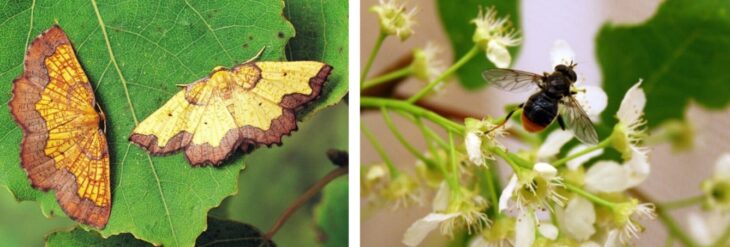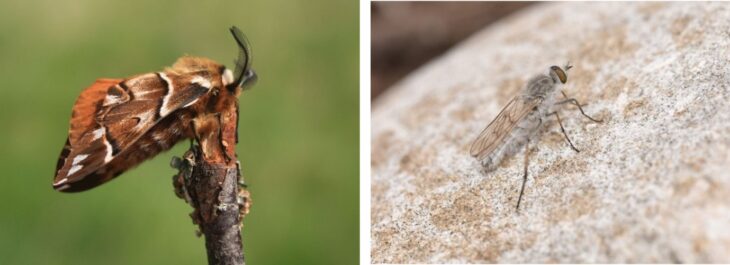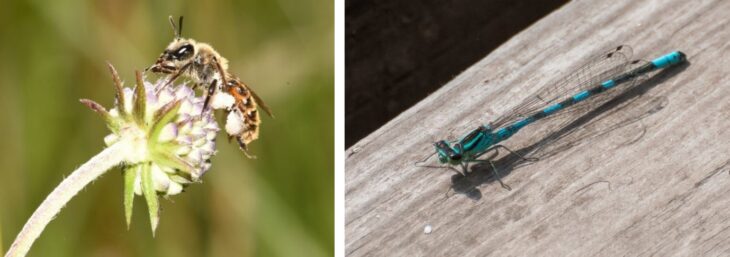About us
Rare Invertebrates in the Cairngorms – how volunteer observations and habitat management by landowners help rare and under-recorded species
Rare Invertebrates in the Cairngorms – how volunteer observations and habitat management by landowners help rare and under-recorded species

Rare Invertebrates in the Cairngorms (RIC) is a partnership project which started in 2017. It initially focused on six insect species found in the Cairngorms National Park that were rare and/or lacking data and where additional resource could support and enhance the work of partner organisations.
The partnership includes RSPB Scotland, Buglife Scotland, Butterfly Conservation Scotland, NatureScot, Royal Zoological Society Scotland (RZSS) and the Cairngorms National Park Authority (CNPA). RSPB Scotland hosts the project and a representative from each organisation makes up the project steering group.
To date, RIC has worked on eight focal species, some for only part of the project period. These species were chosen to have slightly different activity periods for surveying, to help maximise the opportunities for recording:
- Dark Bordered Beauty (Epione vespertaria)
- Pine Hoverfly (Blera fallax)
- Small Scabious Mining Bee (Andrena marginata)
- Kentish Glory (Endromis versicolora)
- Northern February Red Stonefly (Brachyptera putata) 2017-21
- Northern Silver Stiletto Fly (Spiriverpa lunulata) 2017-2023
- Shinning Guest Ant (Formicoxenus nitidulus) 2017-20
- Northern Damselfly (Coenagrion hastulatum) 2021 only

As part of the project, 12 species champion volunteers were established to lead on surveys and training, and act as ambassadors for each of the original six species. A recent interview with Pete Moore outlines his role as the Dark Bordered Beauty champion. Over 100 volunteers have now been involved in RIC, an average of 30 volunteers participating in the project each year. In addition, five student projects and three non-student research projects have worked with RIC.
The partnership has worked with 23 landowners to carry out habitat improvement work , and carried out surveys for the focal species across the Cairngorms, improving knowledge of their distribution and discovering new breeding sites. For example the project has recorded 262 adult and 62 egg/larvae Kentish Glory, which was previously a data deficient species.
The results of these surveys have informed re-introduction projects for Pine Hoverfly with over 18,000 released and Dark Bordered-Beauty, with over 1900 released. The findings have also helped target habitat management, including the creation of over 800 pine stumps to monitor and release Pine Hoverfly, aspen protection for Dark Bordered Beauty and actions taken to increase and join up the habitat for Small Scabious Mining Bee by planting Devils’ Bit Scabious and protecting areas from mowing.

All RIC data with the exception of Pine Hoverfly is shared with the NBN Atlas Scotland. Data for Dark Bordered Beauty is added to the NBN Atlas but at 10km resolution and without site names, to protect the locations of this species.
Species specific steering groups exist for Pine Hoverfly and Dark Bordered Beauty and the RIC Project Officer works closely with staff from all partner organisations to deliver actions for each species. Since 2020 this has included dedicated RZSS invertebrate captive breeding staff. From 2025, the RIC will start work on a new focal species, the Aspen Hoverfly (Hammerschmidtia ferruginea). Eleanor Barrie, the current Project Officer can be contacted at: eleanor.barrie@rspb.org.uk.
The RIC would like to thank their funders; from 2017-2019 the Scottish Government and the European Community LEADER 2014-2020 programme; from 2020 the CNPA and RSPB Scotland, with contributions from Biodiversity Challenge Fund (via CNPA) Cairngorms Connect (via the Endangered Landscapes Programme), the Cairngorms Trust Green Recovery fund and between 2021-2023, the Nature Restoration Fund. The project is funded by the Cairngorms Trust Networks for Nature Fund for 2024-25.
This biodiversity data story was shared by Rare Invertebrates in the Cairngorms with the Better Biodiversity Data project, led and managed by the NBN Trust and supported by NatureScot and The Scottish Government.

